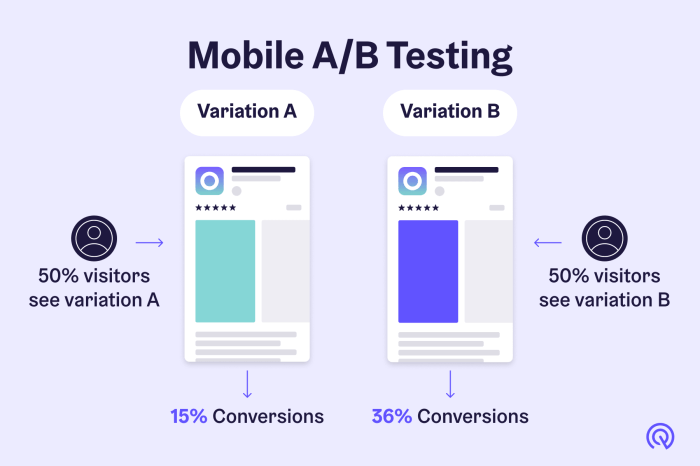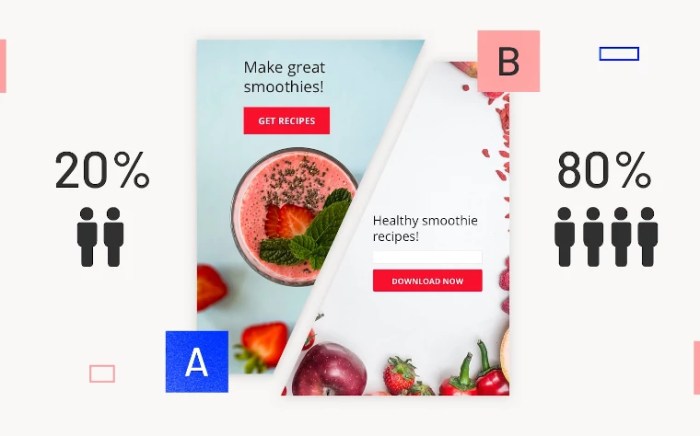Using A/B Testing in Marketing opens up a world of possibilities for optimizing your strategies and maximizing ROI. Dive into the realm of data-driven decisions and watch your campaigns soar to new heights.
Learn the ins and outs of A/B testing, from setup to implementation, and discover how to unlock the full potential of your marketing efforts.
Introduction to A/B Testing

A/B testing in marketing is a method used to compare two versions of a webpage, email, or app to see which one performs better. By randomly showing these variations to different segments of your audience, you can determine which one leads to more conversions or desired actions.The purpose of A/B testing is to optimize marketing strategies by making data-driven decisions.
It helps identify what resonates with your audience, leading to improved engagement, click-through rates, and ultimately, higher conversion rates.
Benefits of A/B Testing
- A/B testing allows you to understand customer behavior and preferences better.
- You can test different elements such as headlines, images, call-to-action buttons, and more to see what works best.
- It helps in reducing guesswork and making informed decisions based on actual data.
- By continuously testing and optimizing, you can improve the overall effectiveness of your marketing campaigns.
Examples of A/B Testing in Marketing
- Testing different subject lines in email campaigns to see which one leads to higher open rates.
- Changing the color of a call-to-action button on a landing page to determine which color drives more clicks.
- Testing two variations of a product page to see which layout results in more purchases.
- Comparing different ad copies on social media to identify the messaging that resonates best with your target audience.
Setting up A/B Tests
When setting up an A/B test, there are several key steps to follow to ensure accurate results and meaningful insights. First, clearly define your objectives and what you hope to achieve through the test. Next, identify the specific elements of your marketing campaign that you want to test, such as different ad copy, images, or calls to action. Then, create variations for each element to test against the control group.
Determining Variables to Test
To determine which variables to test in A/B testing, start by analyzing your marketing goals and target audience. Consider which elements of your campaign could have the most impact on your desired outcomes. This could include testing different headlines, colors, layouts, or messaging. It’s important to focus on variables that are likely to influence user behavior and conversion rates.
Selecting Sample Size
When selecting a sample size for A/B tests, it’s crucial to ensure that you have enough data to draw statistically significant conclusions. Use online calculators or statistical tools to determine the sample size needed based on the expected effect size, significance level, and statistical power. It’s important to balance having a large enough sample size to detect meaningful differences while also considering practical limitations such as budget and time constraints.
Implementing A/B Testing: Using A/B Testing In Marketing

Implementing A/B testing in marketing campaigns requires the use of specific tools and software to set up, run tests, and analyze results effectively. It is essential to follow best practices to ensure accurate interpretation of data and make informed decisions based on the test outcomes.
Tools and Software for A/B Testing, Using A/B Testing in Marketing
- Google Optimize: A free tool by Google that allows for easy A/B testing and personalization.
- Optimizely: A popular platform for A/B testing that offers advanced features and analytics.
- VWO (Visual Website Optimizer): Helps in conducting A/B tests for websites and provides detailed insights.
- Crazy Egg: Provides heatmaps and other visual data to understand user behavior for A/B testing.
Best Practices for Implementing A/B Testing
- Define clear objectives and hypotheses before conducting A/B tests to ensure meaningful results.
- Test one element at a time to accurately attribute any changes in performance to specific variables.
- Ensure a large enough sample size to make statistically significant conclusions from the test results.
- Randomize the assignment of users to different test variations to avoid bias in the results.
- Monitor the tests regularly and be prepared to make adjustments based on the interim results.
Analyzing and Interpreting A/B Test Results
- Look at key metrics such as conversion rates, click-through rates, and engagement to determine the impact of test variations.
- Use statistical significance to validate the results and make informed decisions on implementing changes based on the test outcomes.
- Consider the long-term effects of the changes and analyze the results in the context of overall marketing goals and strategies.
A/B Testing Strategies
When it comes to A/B testing in marketing, there are various strategies that can be implemented to optimize campaigns and maximize ROI. Let’s delve into some of the key A/B testing strategies used by marketers.
Segmentation Testing
Segmentation testing involves dividing your audience into different segments based on specific criteria such as demographics, behaviors, or interests. By testing different variations of your campaign on these segmented groups, you can gain valuable insights into what resonates best with each segment.
Content Testing
Content testing focuses on testing different elements of your marketing content such as headlines, images, or calls-to-action. By experimenting with various content variations, you can determine which elements drive the highest engagement and conversion rates.
Timing Testing
Timing testing involves testing the timing of your campaigns, such as the day of the week or the time of day when your audience is most active. By identifying the optimal timing for your campaigns, you can ensure maximum reach and impact.
Personalization Testing
Personalization testing involves creating tailored experiences for different segments of your audience based on their preferences or past interactions. By personalizing your campaigns, you can increase relevance and engagement, leading to higher conversion rates.
Effectiveness of A/B Testing
A/B testing is widely considered one of the most effective testing methods in marketing due to its ability to provide clear and actionable results. Unlike other testing methods that rely on assumptions or guesswork, A/B testing allows marketers to make data-driven decisions based on real user interactions.
Successful A/B Testing Campaigns
One example of a successful A/B testing campaign is when a company tested two different versions of their landing page and saw a 30% increase in conversions with the winning variation. This demonstrates the power of A/B testing in driving significant improvements in ROI for businesses.